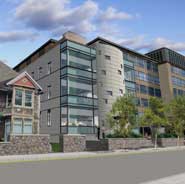Jun 6 2008
A famous mathematical pattern has inspired the stunning curved sail façade of Bristol University’s new £11 million Centre for Nanoscience and Quantum Information.

The façade, which was completed this week, features cladding based on the Fibonacci sequence. It is isolated from the rest of the building to prevent vibration from the wind travelling across it, affecting experiments taking place inside the Centre.
Discovered by Italian mathematician Leonardo Fibonacci in the 12th century, the sequence became widely known after it was described in Dan Brown’s bestselling novel The Da Vinci Code. Starting with 0 and 1, each new number in the series is simply the sum of the two before it. The start of the sequence runs: 0, 1, 1, 2, 3, 5, 8, 13, 21…
The sequence can be found regularly in Nature with spirals on a sunflower head, the arrangement of scales on pine cones and the spiral on snail shells all following the same mathematical pattern.
The Centre for Nanoscience and Quantum Information, built by Willmott Dixon Construction, is a four-storey concrete-framed structure containing some of the quietest laboratories in the world.
Clive Pople, operations director at Willmott Dixon said: “We have never done anything as complex as this and it has certainly been a challenge. Due to the unique nature of the building we have worked extremely closely with the University to ensure that every detail has been implemented correctly. With no other examples in the country to act as benchmark we have been working in completely new territory.”
Brian Drysdale, managing director of Willmott Dixon in the South West said: “The Centre for Nanoscience and Quantum Information is a monumental facility in Bristol which will attract interest from across the globe. We are excited to be working with the University to provide a laboratory which will demonstrate its forward thinking reputation in terms of scientific advances and expertise in this field.
“The completion of the curved entrance is another significant step towards the completion of this cutting-edge project and further enhances this distinct and exciting building.”
Based on Tyndall Avenue, the Centre for Nanoscience and Quantum Information will offer extremely low levels of acoustic noise, vibration and air movements and provide a world class facility for scientific research. As well as addressing deep questions in fundamental science, the research to be carried out in the building will offer opportunities for the development of future computing, communications and health technologies, as well as advanced materials, for example for the aerospace industry.